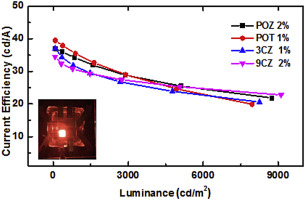Organic Electronics ( IF 2.7 ) Pub Date : 2017-12-27 , DOI: 10.1016/j.orgel.2017.12.033 Jing Li , Yi-Huan Li , Yue Zhao , Xiang-Yang Liu , Man-Keung Fung , Jian Fan

|
Four naphthalene-based host materials, 4′-[8-(4-phenoxazin-10-yl-phenyl)-naphthalen-1-yl]-biphenyl-4-carbonitrile (POZ), 4′-[8-(4-phenothiazin-10-yl-phenyl)-naphthalen-1-yl]-biphenyl-4-carbonitrile (POT), 4′-[8-(9-phenyl-9H-carbazol-3-yl)-naphthalen-1-yl]-biphenyl-4-carbonitrile (3CZ), and 4′-[8-(4-carbazol-9-yl-phenyl)-naphthalen-1-yl]-biphenyl-4-carbonitrile (9CZ), were designed and synthesized, where one electron-donating group and one electron-withdrawing group were covalently linked to the 1,8-positions of each naphthalene unit, respectively. Single crystal X-ray diffraction analyses of the four hosts revealed that the host molecules are held together by intensive non-covalent interactions, such as π⋯π and hydrogen bonding interaction at solid state, which can facilitate carrier transport and migration of excitons and improve the ability of thin film formation. The photophysical properties, thermal stability, and electrochemical behaviors of these hosts were systematically investigated. Red phosphorescent organic light-emitting diodes (PHOLED) based on these host materials with Ir(MDQ)2(acac) as dopant were fabricated and exhibited excellent device performance at low doping concentrations of 1–2 wt% due to the efficient energy transfer and reduced concentration quenching. Remarkably, POT based OLED at the doping ratio of 1 wt% achieved a maximum efficiency of 39.5 cd A−1, 37.6 lm W−1 and 20.3% with Commission Internationale de l'Eclairage (CIE) coordinates of (0.60, 0.40) without an external out-coupling structure. This result is comparable to the best red PHOLEDs with such a low doping ratio, indicating their potential utility as a host for cost-effective and highly efficient red PHOLEDs.
中文翻译:

用于低掺杂率的高效红色磷光OLED的萘基主体材料
四种基于萘的主体材料,4'-[8-(4-phenoxazin-10-yl-phenyl)-萘-1-基]-联苯-4-腈(POZ),4'-[8-(4-吩噻嗪-10-基-苯基)-萘-1-基]-联苯-4-腈(POT),4'-[8-(9-苯基-9H-咔唑-3-基)-萘-1-基设计合成了]-联苯-4-腈(3CZ)和4'-[8-(4-咔唑-9-苯基)-萘-1-基]-联苯-4-腈(9CZ) ,其中一个给电子基团和一个吸电子基团分别与每个萘单元的1,8-位共价连接。对四种主体的单晶X射线衍射分析表明,主体分子通过强烈的非共价相互作用(例如固态的πandπ和氢键相互作用)结合在一起,它可以促进载流子在激子中的迁移和迁移,并提高薄膜形成的能力。系统地研究了这些主体的光物理性质,热稳定性和电化学行为。基于具有Ir(MDQ)的这些主体材料的红色磷光有机发光二极管(PHOLED)由于有效的能量转移和降低的浓度猝灭,制备了2(acac)掺杂剂,并在1-2 wt%的低掺杂浓度下表现出优异的器件性能。值得注意的是,基于POT以1%(重量)的掺杂率OLED实现39.5 CD A的最大效率-1,37.6流明w ^ -1无(0.60,0.40),并用委员会国际照明委员会(CIE)20.3%的坐标外部耦合结构。该结果可与具有如此低掺杂率的最佳红色PHOLED媲美,表明它们潜在地用作成本效益高且效率高的红色PHOLED的主体。










































 京公网安备 11010802027423号
京公网安备 11010802027423号